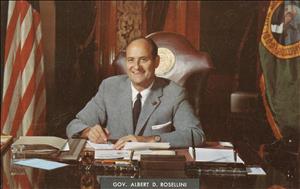On February 20, 1963, Washington Governor Albert Rosellini (1910-2011), a liberal Democrat, convenes the Washington State Commission on the Status of Women. He is the second governor in the country to do so, following the organization of a national presidential commission. The 29-member panel is chaired by Mildred Dunn, of Seattle. Meetings are held throughout the state. The Governor's Report on the Status of Women in Washington State, will published later the same year.
Washington Women Workers in 1960
The Washington State Commission used U. S. Census Bureau and U. S. Department of Labor statistics to assemble information on Washington women workers. In 1960, there were 344,478 women workers in the state. These women constituted 31 percent of the labor force. Of these workers, 11,083, or 3 percent, were "non-white" women. The resulting report stated, "The participation of women in the labor force increases with age, reaching a maximum of 41% of all women in the 45 to 64 age group -- the age when family responsibilities are at a minimum."
The occupations of the working women were:
- Clerical 105,207
- Professional and technical work 46,775
- Managerial or office occupations 14,523
- Sales 26,684
- Private household work 23,362
- Service occupations (other than private household) 51,270
- Craftsmen, foremen, and operatives 29,000
Despite the "Equal Pay for Comparable Work" law in the state of Washington, women workers earned less than men, and "Negro" (African American) women earned a little more than half as much as white women.
The commission made a number of recommendations, particularly focussing on the idea that the government itself and its agencies should end practices, such as specifying "male only" and "female only" positions, which result in discrimination against women.
Until Workers?
As for women in private industry, the image of the woman as a temporary worker was found to be a problem. The report states:
"Women who have considered their positions secondary have created the image of women as temporary workers in the minds of employers. Many women think of themselves as 'Until Workers' — they plan to work 'until marriage'; 'until the house is paid for'; 'until the car is paid for'; 'until the baby comes'; 'until her husband finishes college'; or any number of other 'untils'!"
The report commented at length on the need for adequate childcare and refuted notions that the employment of women contributed to juvenile delinquency and other social problems.
An Aptitude for Engineering
The subcommittee on Education reported that aptitude tests given to high school students indicate that 6.3 percent of the boys and 4.2 percent of the girls show an aptitude for engineering. Yet only eight-tenths of 1 percent of the nation's engineers were women. The committee urged vocational counselors to encourage girls to go into engineering.
Agriculture
A subcommittee reporting on migrant workers stated:
"Washington's seasonal workers are composed of diverse ethnic groups — Indians from British Columbia, our own on and off-reservation Indians, Latin-Americans from Texas and other southwestern states, negroes and whites. There are cultural differences, but there is one overwhelming similarity — poverty."
This subcommittee noted the health hazard posed by pesticides, and the need for childcare.
Government
The subcommittee on Women as Citizen Volunteers in Government found that men overwhelmingly held state elective offices. This included 99 percent of state legislative offices; all executive and judicial offices; 88. 5 percent of the school boards; 265 out of 267 city mayors (two women mayors); and 934 men and 66 women City Council members. The remarkable exception was library boards. Women held 98 percent of seats on Library Boards in the state of Washington.
Members of the Governor's Commission on the Status of Women were:
- Mrs. Mildred Dunn, Chair
- Miss Maryan Reynolds
- Mr. Jack Jarvis
- Mrs. John T. Strickland, Bellevue
- Judge Evangeline Star, Seattle
- Mr. Jack Steinberg, Seattle
- Mrs. Bernice Kirk, Seattle
- Miss Lillian Butler, Yakima
- Mr. Joe DiJulio, Seattle
- Mrs. Margaret Smith, Port Orchard
- Miss Ruth Cullin, Bremerton
- Mrs. Marie Woolcott, Spokane
- Mrs. Mary Beth Bryan, Bellevue
- Mayor Alma Kemper, Milton
- Mrs. Christine Meade, Seattle
- Mr. Paul Green, Bellevue
- Mr. A. M. McLean, Seattle
- Mr. Max Silver, Seattle
- Mrs. Helen Haller, Sequim
- Dr. Paul H. Landis, Pullman
- Mrs. Helen Nelson, Aberdeen
- Mrs. Vivian McBraun, Mirror Lake
- Mrs. Irene Nelsen, Seattle
- Mrs. Dorothy Button, Bellingham
- Mrs. Winifred Young, Seattle
- Mrs. Gladys Burns, Olympia
- Mrs. Veronica Booker, Seattle
- Mrs. Rudolph Schmidt, Yakima
The organization of the Washington State Commission followed the formation of the national Presidential Commission on the Status of Women established by U.S. President John F. Kennedy (1917-1963). On the national level, the prime mover in this effort was Esther Peterson, head of the Women's Bureau, a division of the U.S. Labor Bureau. She organized a coalition of labor and liberal organizations to pressure President John Kennedy to create a special commission to explore women's status in the United States. Eleanor Roosevelt served as the first chair. The report, entitled The Presidential Report on American Women was published in 1963.

